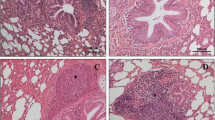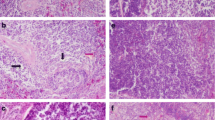Abstract
Exudative diathesis, a condition caused by a selenium (Se)/vitamin E deficiency, was studied in chicks. Trios of chicks that showed clinical signs of exudative diathesis were matched for severity. One was injected subcutaneously with 0.5 mL distilled water, and the other two received 15 μg of Se in 0.5 mL distilled water. A chick fed a diet with supplemental Se also received 0.5 mL distilled water. Blood was collected from three chicks 2 d after injection, and from the other chick, 6 d after injection. After blood was collected, pectoral muscle and bone marrow were collected. Deficient chicks showed varying degrees of necrosis in pectoral muscle, whereas recovring chicks had extensive fibrosis in pectoral muscle. An analysis of blood showed differences in CO2, glucose, Se, glutathione peroxidase, alanine aminotransferase, aspartate aminotransferase, and creatine kinase. Heterophils and monocytes were increased in deficient chicks; lymphocytes, basophils, and hemoglobin decreased. After 6 d of recovery, all of the changes noted above were correcting toward normal. Eosinophils, in contrast, were unaffected by a deficiency, but increased in recovering chicks. It is hypothesized that cytokines associated with the inflammatory response accentuate the clinical signs of exudative diathesis.
Similar content being viewed by others
References
H. Dam and J. Glavind, Alimentary exudative diathesis,Nature 142, 1077–1078 (1938).
H. Dam and J. Glavind, Alimentary exudative diathesis, a consequence of E-avitaminosis.Nature 143, 810–811 (1939).
E. L. R. Stokstad, E. L. Patterson, and R. Milstrey, Factors which prevent exudative diathesis in chicks on Torula yeast diets [Abstract],Poultry Sci. 36, 1160 (1957).
M. L. Scott, J. G. Bieri, G. M. Briggs, and K. Schwarz, Prevention of exudative diathesis by Factor 3 in chicks on vitamin E-deficient Torula yeast diets [Abstract],Poultry Sci. 36, 1155 (1957).
T. Noguchi, A. H. Cantor, and M. L. Scott, Mode of action of selenium and vitamin E in prevention of exudative diathesis in chicks,J. Nutr. 103, 1502–1511 (1973).
M. L. Scott, M. C. Nesheim, and R. J. Young,Nutrition of the Chicken, 3rd ed., M. L. Scott and Associates, Ithaca, pp. 350–353 (1982).
T. S. Koh and T. H. Benson, Critical re-appraisal of fluorometric method for determination of selenium in biological materials,J. Assoc. Off. Anal. Chem. 66, 918–926 (1983).
R. P. Burk and R. A. Lawrence, Glutathione-peroxidase activity in selenium deficient rat liver,Biochem. Biophys. Res. Commun. 71, 952–958 (1976).
C. Riddell, Muscular system, inAvian Histopathology, American Association of Avian Pathologists, Kennett Square, PA, pp. 27–30 (1987).
C. Riddell, Cardiovascular system, inAvian Histopathology, American Association of Avian Pathologists, Kennett Square, PA, pp. 31–36 (1987).
R. E. Austic and M. L. Scott, Nutritional diseases, inDiseases of Poultry, 9th ed., B. W. Calnek, H. J. Barnes, C. W. Beard, W. M. Reid, and H. W. Yoder, Jr. eds., Iowa State University Press, Ames, IA, pp. 45–71 (1991).
J. Kuby,Immunology, 2nd ed., W.H. Freeman, New York, pp. 7–15,313–316 (1994).
L. R. McDowell, Selenium, inMinerals in Animal and Human Nutrition, Academic, New York, pp. 294–332 (1992).
Author information
Authors and Affiliations
Rights and permissions
About this article
Cite this article
Bartholomew, A., Latshaw, D. & Swayne, D.E. Changes in blood chemistry, hematology, and histology caused by a selenium/vitamin E deficiency and recovery in chicks. Biol Trace Elem Res 62, 7–16 (1998). https://doi.org/10.1007/BF02820016
Received:
Accepted:
Issue Date:
DOI: https://doi.org/10.1007/BF02820016




